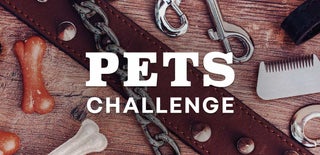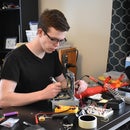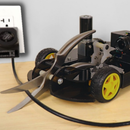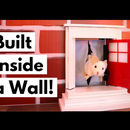Introduction: Leather Dog Collar
Decorative dog collars can be expensive but the process for making your own is fairly simple and enjoyable! The same techniques can be applied to making belts, and perhaps lead you to try making other leather projects.
A while ago I made about 40 collars to sell at a local pet store. A lot of the photos in this post are from an old Instagram account I had, that I used to promote the sale of my collars (hence I apologize for the excessive filters on some of the photos)!
Step 1: Materials and Tools
Parts
- Full grain leather (2 grades higher than the more commonly used: genuine leather). You can either get:
- Belt buckle (choose your own style, make sure it is the correct width for your leather strip)
- Chicago screws (at least 3)
- D-rings
- Gum Tragacanth
- Leather deglazer
- Leather dye, I am fan of antique leather dyes, they look great especially with stamps because the crevasses accumulate dye making them darker. They are also give a soft/smooth feel. There are plenty of other variations and colours to choose from.
- Water resistant sealer. See this page for a comparison of brands.
Tools
Tools can be expensive, especially to begin with because you will need quiet a few. I am fortunate to have a relative who is into leather work and has accumulated a collection of her own, I also acquired some more through local community. To begin with I would suggest seeing if there is a local leather community you can borrow from or a group you can join. Second hand tools are also great, the stamps are usually still good after decades and tools like a swivel knife can be sharpened with the appropriate stones. Below is a selection of suggested tools, but if you are inventive you might be able to MacGyver your own!
- Hole punch (circular)
- Leather mallet
- Oblong leather punch
- Granite slab for tooling on
- Swivel knife for carving
- Leather end punch or sturdy scissors
- Edge beveler
- Edge slicker
- Leather shaver
- Bone folder
- Decorative stamping tools
- Leather strap cutter (if you bought a full hide instead of pre cut leather strips)
- Clean rags/brushes/sponges
Gloves and scrap paper (you'll want these for dyeing)!
Most of the product links in this instructable go to Tandy Leather, I am not sponsored by them, it is just the most dominant location for finding leather products in North America. You might also find the same products on amazon.com or perhaps local leather/craft/fabric stores. Similarly most of the dyes are from Feibing's, there is another company called Eco-Flow for similar products, as well as others.
Step 2: Cut and Prepare Leather
The first step is to cut the leather. The best way to do this is using a leather strap cutter, you can choose your desired width (1 or 1.5 inches is fairly standard) and then pull it through the leather. See this video for an example. It is also possible to cut leather with an x-acto knife.
There is no hard and fast formula for the size to cut the leather. I will leave it as a creative decision for you. Most buckles come in 1 inch or 1.5 inch sizes, so depending on the build of you dog choose the appropriate size. Again length of the collar will depend on the size of your dog. A general rule of thumb is to ensure that 2 fingers can fit comfortably between the collar and the neck. Add about 3 inches to the length so it can be doubled back on itself to secure the buckle and D-rings.
Next cut the ends to your desired shape (for example rounded, v-shaped or tapered) this can be done with a specific tool like an end punch, or with an x-acto knife. See pictures above for an example of rounded ends.
Use the beveler to trim the edges. To do this simply glide the beveler tool along the edge, striping off the sharp 90 degree angle. See this video. The end result will be a lot of pieces of 'leather spaghetti' as in the pictures above. Don't rush this step, spend the time to make sure the edges are rounded and soft, your dog will appreciate the extra of care.
Next to further smooth off the edges, you can use a plastic or wooden slicker. Start by putting a small amount of Gum Tragacanth, or similar, on the slicker and rub briskly. This will burnish the edges, giving them a nice smooth, rounded finish, far more comfort around the neck! Be careful because too much Gum Tragacanth can prevent the leather from fully absorbing the dye, leaving it paler in some areas. I am sure there are other alternative products, however I personally only ever used Gum Tragacanth. Optionally you can also use the Gum Tragacanth and the bone folder tool to brush smooth the underside of the collar that is in contact with the neck.
Now for the holes; similar to a belt I usually make about 6 holes for the buckle pin to go through, I would advise having a few holes on either side of the central hole to allow for slight stretching of the leather over time.
At the other end of the collar use the oblong hole punch to make a hole for the belt buckle (set back 3 inches from the end), with 3 holes symmetrically placed on either side (see picture above). These holes will be joined together using chicago screws with D-rings in between for the leash and dog tags to be attached to. To ensure these last 3 inches of leather fold over easily, I advise stripping away some of the underside leather with a leather shaver (in picture above)
Step 3: Tooling (optional)
If you are happy with a traditional leather collar (or if you are making a standard belt with a longer piece of leather) and don't want to stamp it, you may skip this step.
Stamping is a creative process, it is up to you in the choice of your design but here are a few general tips:
- Dampen the leather with a wet sponge initially, this will make stamping easier.
- A single hit with the mallet is better than lots of small taps, the stamping tool will jump around and result in multiple stamps instead of one clean stamp.
- Use scrap leather first! Experiment with designs and the amount of force to hit the stamping tool.
- Be careful when doing symmetric patterns, it will be obvious if you make a mistake when symmetry is broken.
- Lastly have fun and don't worry too much. As the artist you'll always notice your mistakes more than anyone else will. If the stamps aren't all perfectly aligned, don't worry, no-one is going to study it intensely.
Step 4: Cleaning, Dyeing, Sealing
As always it is best to work in a ventilated room, with scrap paper/ newspaper, and disposable gloves to prevent unwanted staining. Always ensure the dye is dry after each layer before applying the next.
During the construction process it is likely your leather has accumulated specks of dirt, dust and finger oil. Firstly we want to clean the leather. You can do this by wiping it down with a clean rag, or using a leather deglazer. Simply wipe the leather down with a small amount of deglazer on a white cloth, allow the leather to air dry.
In terms of dyes and colours, I am fan of antique leather dyes that are brown, natural colours, they look great in the sunlight, especially with stamps because the crevasses accumulate dye making them darker in the stamped areas. Leather that is dyed with antiques in general have a softer/smoother feel. There are plenty of other variations and colours to choose from. Shop around and see what you like.
If you want you can use an edge dye for your collars, these are special dyes intended for use on the edge, giving a nice finish. Edge dyes are a luxury and I personally just used regular dye on the sides too. One easy to overlook area when dyeing is the holes, it might sound obvious but make sure you get the dye covering the inside of the holes too, or the raw leather colour it will stick out when finished.
Allow the dye to dry and buff with a cloth or ideally something like rabbit fur. However if the dye is not dry before buffing, some of the hairs will stick on the dye and ruin the finish!
I personally used Super Sheen to protect my collars but here is a list of some others to make an informed decision. The application process is similar; when the previous layer is fully dry, brush on a thin layer, getting into all the stamped areas too. Allow to dry. Buff with a soft cloth or fur.
Step 5: Assembly
Once the dye is dry the collar can be assembled. To do this slide the buckle into is oblong slot and then attach a pair of D-rings, followed by a 3rd, singular D-ring, each section separated with a chicago screw.
The double D-rings are to attach a leash and the single D ring for a dog tag.
Initially the leather will be a little stiff, but with a wear it will soften.
Step 6: General Care
Depending on what sealant you used in the previous step will change how to care for the collar. Follow the instructions given by the manufactures. Here are some general remarks that are applicable in most situations.
- While sealing the collar will make it water/sweat/splash resistant, I would advise against swimming with it on or in heavy rain. This will significantly decrease the lifetime of the collar and possibly lead to stretching.
- Extended sunlight exposure will age the collar over time. Some people like this aesthetic, however if not you can always make another collar after the first one ages. Experiment with new colours and patterns!
Step 7: Extra
Always try new things! If you want more project ideas try adapting the technique in this instructable into making bracelets, hair pieces or martingale style dog collars.

Runner Up in the
Pets Challenge













